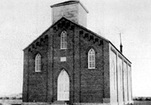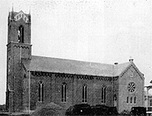
St. Michael’s First Church dedicated December 1, 1878 by the Most Rev. R. Gilmore, D.D. Bishop of Cleveland was erected at a cost of $3,045.90 under the direction of Father John Mueller, pastor of Ottoville. Councilmen of that day were Andrew Edelbrock, Clemens Wehri and Ferdinand Hersing.

The Second Church of the parish was the reconstruction of the first edifice in 1894 at a cost of $4,998.28 under the pastorate of Father Chrysostom Hummer, C.PP.S. The rebuilt church was dedicated May 17, 1896, by the Most Rev. Ignatius Horstman, D.D., Bishop of Cleveland. Councilmen were Henry Gerdeman, L.J. Smith, Henry Brinkman, J.H. Recker, Andrew Ellerbrock, Joseph Erhart, John Knueve.

St. Michael’s Present Church – Ground was broken on May 19, 1924 and the corner stone was laid on August 31, 1924, the most Rev. Samuel A. Strich, D.D., Bishop of Toledo who also officiated at the dedication on May 2, 1926. Councilmen were Mathias Gerdeman, August Hohenbrink, Charles Siebeneck and Louis Smith.
The following historical account was compiled by Nora Basinger for the Putnam County Historical Book, published in 2005.
The church of St. Michael the Archangel is an imposing and beautiful structure that has graced the Kalida landscape for 78 years. It gives quiet testimony to the zeal and faith of the early settlers.
In 1861, a group of devout Catholic farmers petitioned the Ecclesial Authority for permission to build their own community church. Permission was granted, but the move of the County seat from Kalida to Ottawa would delay them for another 17 years. Finally, in 1878, their dream was realized and the first St. Michael Church became a reality. It had no heat, bare floors, no tower and no organ. This did not dampen their enthusiasm for their new parish. They were a mission outpost. The Rev. Fr. Roches made a weekly trip by mail hack from Glandorf to say Mass and administer the sacraments. In 1888, the Congregation of the Precious Blood was put in charge of the small parish and has done so since. In 1883, the parish purchased two acres of land next to Union Twp. Cemetery for $250 and St. Michael's Cemetery was started. It has expanded a great deal since that time.
By 1896, the congregation had outgrown the small church, so an addition was put on. Also, a bell tower was added and a small rectory for the resident priest. In 1903, Fr. Valentine Shirack, the pastor, raised funds for an organ to be installed. He purchased a grand pipe organ from Henry Pilcher & Sons. He also supervised the installation of sidewalks, the placing of two bells in the tower, the erection of a fence and the installation of a hot air furnace.
The parish decided that a parochial school was needed. In 1905, St. Michael's Parochial school opened its doors. The Sisters of Divine Providence served the parish as teachers until the mid-1980's. Housing for them was provided by the parish, which built a convent for them next to the school.
By the 1920's, the congregation had, again, outgrown its space and the decision was made to erect a new building. Fr. Michael Muehe, pastor at that time, had a daunting task, but attacked it with zeal. With the help of committees, he raised funds, hired architects, chose designs and took care of the many details. On August 31, 1924, the first foundation stone was put in place. When the project had been completed in 1926, a formal dedication was held on May 2 of that year.
The end result was a stately, magnificent building, whose campanile soared 135 feet into the air, topped with a huge golden cross. It is done in the Lombardic-Romanesque style of Northern Italy . Its roof is red, Spanish tile. Its stained-glass windows are irreplaceable and full of symbolism and the body of the church is made of hydraulic brick, reinforced with steel.
In the 1950's, the interior was in need of freshening, so artisans were hired and a Byzantine décor used. The results were beautiful. By the mid 1970's, water damage appeared, so the interior was repainted. It soon became apparent that structural repair was needed.
In the 1990's, Fr. John Hoying spearheaded the effort and the entire building was tuck-pointed, the roof was repaired and the interior returned to the Byzantine splendor it once had. Faux marble painting was used on the pillars and sidewalls and real gold leafing added beauty and richness. After Father Hoying was reassigned, Fr. Scott Kramer became the new pastor and set about preserving the beautiful windows. They were removed, cleaned and sheathed in a protective coating before being replaced.
The 100 year old organ became his next project. With the help of a fine committee, the firm of Rodgers/Ruffati was hired. The old organ was removed and components saved for use in the new Rodgers/Ruffati/Pilchers digital/pipe combination organ. On October 10, 2004, Dr. Jeanine Cansler, a concert organist, performed before a packed church and it was thrilling. This great organ befits the sacred space in which it will be used and will be a complement to our many fine choirs.
The congregation has grown from a few families to approximately 900. The parish is very active with many volunteering their time, talent and treasure. Over 150 people are involved in the music ministry and 600 students participate in the Religious Education program, in addition to the numerous other ministries and committees.
The current parishioners are continuing the tradition of their ancestors of building a strong community of faith, family & service. The hardy people who planted the first seeds of St. Michael's would be proud, one can be sure, not only of the fine edifice that has been so well cared for, but of the good people who comprise our parish.
The church of St. Michael the Archangel is an imposing and beautiful structure that has graced the Kalida landscape for 78 years. It gives quiet testimony to the zeal and faith of the early settlers.
In 1861, a group of devout Catholic farmers petitioned the Ecclesial Authority for permission to build their own community church. Permission was granted, but the move of the County seat from Kalida to Ottawa would delay them for another 17 years. Finally, in 1878, their dream was realized and the first St. Michael Church became a reality. It had no heat, bare floors, no tower and no organ. This did not dampen their enthusiasm for their new parish. They were a mission outpost. The Rev. Fr. Roches made a weekly trip by mail hack from Glandorf to say Mass and administer the sacraments. In 1888, the Congregation of the Precious Blood was put in charge of the small parish and has done so since. In 1883, the parish purchased two acres of land next to Union Twp. Cemetery for $250 and St. Michael's Cemetery was started. It has expanded a great deal since that time.
By 1896, the congregation had outgrown the small church, so an addition was put on. Also, a bell tower was added and a small rectory for the resident priest. In 1903, Fr. Valentine Shirack, the pastor, raised funds for an organ to be installed. He purchased a grand pipe organ from Henry Pilcher & Sons. He also supervised the installation of sidewalks, the placing of two bells in the tower, the erection of a fence and the installation of a hot air furnace.
The parish decided that a parochial school was needed. In 1905, St. Michael's Parochial school opened its doors. The Sisters of Divine Providence served the parish as teachers until the mid-1980's. Housing for them was provided by the parish, which built a convent for them next to the school.
By the 1920's, the congregation had, again, outgrown its space and the decision was made to erect a new building. Fr. Michael Muehe, pastor at that time, had a daunting task, but attacked it with zeal. With the help of committees, he raised funds, hired architects, chose designs and took care of the many details. On August 31, 1924, the first foundation stone was put in place. When the project had been completed in 1926, a formal dedication was held on May 2 of that year.
The end result was a stately, magnificent building, whose campanile soared 135 feet into the air, topped with a huge golden cross. It is done in the Lombardic-Romanesque style of Northern Italy . Its roof is red, Spanish tile. Its stained-glass windows are irreplaceable and full of symbolism and the body of the church is made of hydraulic brick, reinforced with steel.
In the 1950's, the interior was in need of freshening, so artisans were hired and a Byzantine décor used. The results were beautiful. By the mid 1970's, water damage appeared, so the interior was repainted. It soon became apparent that structural repair was needed.
In the 1990's, Fr. John Hoying spearheaded the effort and the entire building was tuck-pointed, the roof was repaired and the interior returned to the Byzantine splendor it once had. Faux marble painting was used on the pillars and sidewalls and real gold leafing added beauty and richness. After Father Hoying was reassigned, Fr. Scott Kramer became the new pastor and set about preserving the beautiful windows. They were removed, cleaned and sheathed in a protective coating before being replaced.
The 100 year old organ became his next project. With the help of a fine committee, the firm of Rodgers/Ruffati was hired. The old organ was removed and components saved for use in the new Rodgers/Ruffati/Pilchers digital/pipe combination organ. On October 10, 2004, Dr. Jeanine Cansler, a concert organist, performed before a packed church and it was thrilling. This great organ befits the sacred space in which it will be used and will be a complement to our many fine choirs.
The congregation has grown from a few families to approximately 900. The parish is very active with many volunteering their time, talent and treasure. Over 150 people are involved in the music ministry and 600 students participate in the Religious Education program, in addition to the numerous other ministries and committees.
The current parishioners are continuing the tradition of their ancestors of building a strong community of faith, family & service. The hardy people who planted the first seeds of St. Michael's would be proud, one can be sure, not only of the fine edifice that has been so well cared for, but of the good people who comprise our parish.
